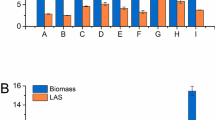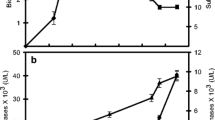Summary
Glucan formation ofSchizophyllum commune andSclerotium glucanicum were investigated. Process data obtained during batch cultivation are presented. Glucan release can be improved by oxygen limitation. Thus, growth and glucan release are influenced by oxygen in opposite ways. Possible pathways of this oxygen-dependent regulation are discussed. A draft-tube/propeller system, rushtonturbine-, fan- and helicon-ribbon-impeller as well as a fundaspi and intermig agitator were tested. The 4-bladed fan impeller withd *=0.64 yielded the best results, since effective bulk mixing is much more important than bubble break up (micromixing) with regard to this system. Fed-batch cultivation always resulted in higher rates of glucan formation than the batch process.
Similar content being viewed by others
References
Bartnicki-Garcia, S. 1973. Fundamental aspects of hyphal morphogenesis. Symp. Soc. Gen. Microbiol. 23: 245–267.
Bluhm, T.L., Y. Deslandes and R.H. Marchessault. 1982. Solid-state and solution conformation of scleroglucan. Carbohydr. Res. 100: 117–130.
Brauer, H.. 1971. Grundlagen der Ein- und Mehrphasenströmung. Sauerländer Verlag, Frankfurt a.M., F.R.G.
Catley, B.J. 1983. Regulation of yeast and fungal polysaccharides excluding chitin and cellulose. In: Progress in industrial microbiology, (Bushel, M.E., ed.) 18: 129–200, Elsevier, Amsterdam.
Compere, A.L. and L. Griffith. 1981. Scleroglucan biopolymer production, properties and economics. In: Advances in Biotechnology (Moo-Young, M., ed.) 3: 541–546, Pergamon Press, New York.
Evans, B. 1980. Relationships between morphology and metabolism in the dimorphic fungus Mycothypha. Ph. D. Thesis, Technical University of Braunschweig, F.R.G.
Garraway, M.O. and R.C. Evans (eds.). 1984. In: Fungal nutrition and physiology, John Wiley and Sons, New York.
Gbwonyo, K., D. Dimasi and B.C. Buckland. 1986. The use of hydrofoil impellers to improve oxygen transfer efficiency in viscous mycelial fermentations. In: Int. Conf. on Bioreactor Fluid Dynamics, pp. 281–299, Cambridge, England.
Griffith, W.L. and A.L. Compere. 1978. Production of a high viscosity glucan bySclerotium rolfsii ATCC 15206. Dev. Ind. Microbiol. 19: 609–617.
Haarstrick, A., U. Rau and F. Wagner. 1990. Cross flow filtration as a method of separating fungal cells and purifying the polysaccharide produced. Bioproc. Eng., submitted.
Halleck, F.E. 1967. Polysaccharides and methods for production thereof. US Patent 3.301.848.
Kashiwagi, Y., T. Norisuye and H. Fuyita. 1981. Triple helix ofSchizophyllum commune polysaccharide in dilute solution. Macromol., 14: 1220–1225.
Kipke, K.D. and E. Todtenhaupt. 1982. Rühren von nicht-Newtonschen Flüssigkeiten. Verfahrenstechnik 16: 497–503.
Lawford, H. and J. Rousseau. 1989. Effect of oxygen on the rate of β-1,3-glucan microbial exopolysaccharide production. Biotechnol. Lett. 11: 125–130.
Münzer, S. 1989. Produktion und Charakterisierung eines vonSchizophyllum commune ATCC 38548 gebildeten extrazellulären β-1,3-glucans. Ph. D. Thesis, Technical University of Braunschweig, F.R.G.
Nickerson, W. and F. Falcone. 1956. Identification of protein disulfide reductase as a cellular division enzyme in yeasts. Science, 124: 722–723.
Norisuye, T., T. Yanaki and H. Fujita. 1980. Triple helix of aSchizophyllum commune polysaccharide in aqueous solution. J. Poly. Sci. 18: 547–558.
Pace, G.W. and R.C. Righelato. 1980. Production of extracellular microbial polysaccharides. In: Adv. Biochem. Eng. (Fiechter, A., ed.), 15: 41–70, Springer Verlag, Hamburg, F.R.G.
Peters, H.U., H. Herbst, E. Widjayanti, A. Schumpe and W.-D. Deckwer. 1990. The influence of agitation rate on xanthan production rate byXanthomonas campestris. Biotechnol. Bioeng., submitted.
Pörtner, R. and U. Werner. 1989. Betrachtungen zur Effektivität von Rührern bei Homogenisierprozessen und viskoelastischen Flüssigkeiten. Chem.-Ing.-Tech. 61: 250–251.
Rau, U. and F. Wagner. 1987. Non-Newtonian flow behaviour of colloid dispers glucan solutions. Biotechnol. Lett. 9: 95–100.
Rau, U., E. Gura, A. Schliephaake and F. Wagner. 1989. Influence of processing on the formation of exopolysaccharides by filamentously growing fungi. In: Dechema Biotechnology Conferences (Behrens, D. and A.J. Driesel, eds.), 3 part B: pp. 571–574.
Rau, U., R.-J. Müller, K. Cordes and J. Klein. 1990. Process and molecular data of branched 1,3-β-d-glucans, in comparison withXanthan. Bioproc. Eng. 5: 89–93.
Rho, D., A. Mulchandini, J.H.T. Luong and A. Le Duy. 1988. Oxygen requirement in pullulan fermentation. Appl. Microbiol. Biotechnol. 28: 361–366.
Rosenthal, G.A. 1985. Colorimetric and fluorimetric detection of amino acids. In: Chemistry and Biochemistry of Amino Acids (Barret, G.C., ed.), pp. 573–590, Chapman and Hall Inc., London.
Schügerl, K. 1981. Oxygen transfer into highly viscous media. In: Advances in Biochemical Engineering (Fiechter, A., ed.) 19: 71–174.
Shamlou, P.A. and M.F. Edwards. 1985. Power consumptions of helical ribbon mixers in viscous Newtonian and non-Newtonian fluids. Chem. Eng. Sc. 40: 1773–1781.
Sietsma, J.H. and J.G.H. Wessels. 1977. Chemical analysis of the hyphal wall ofSchizophyllum commune. Biochim. Biophys. Acta. 496: 225–239.
Steiner, W., R.M. Lafferty, I. Gomes and H. Esterbauer. 1987. Studies on a wild strain ofSchizophyllum commune. Biotechnol. Bioeng. 30: 169–178.
Stephan, D. 1986. Bildung von β-1,3-Glucanen aus Mono-, Di- und Polysacchariden mitSclerotium rolfsii und deren physikochemische Charakterisierung. Ph. D. Thesis, Technical University of Braunschweig, F.R.G.
Sutherland, I.W. 1983. Extracellular polysaccharides. In: Biotechnology (Rehm, H.J. and G. Reed, eds.) 3: 531–574.
Thompson B.G. and W.T. Leps. 1986. Effect of dissolved oxygen on growth and production of exopolysaccharide byRhizobium trifolii. J. Ferment. Technol. 64: 335–338.
Tuffile, C.M. and F. Pinho. 1970. Determination of oxygentransfer coefficients in viscous streptomycete fermentations. Biotechnol. Bioeng. 12: 849–871.
Turian, G. 1976. Reducing power of hyphal tips and vegetative apical dominance in fungi. Experentia. 32: 989–991.
Wessels, J.G.H. and J.H. Sietsma 1979. In: Fungal walls and hyphal growth (Burnett, J.H. and A.P.J. Trinci, eds.), pp. 27–48, Cambridge University Press, Cambridge.
Yanaki, T., T. Kojima and T. Norisuye. 1981. Triple helix of scleroglucan in dilute aqueous sodium hydroxide. Pol. J., 13: 1135–1143.
Author information
Authors and Affiliations
Rights and permissions
About this article
Cite this article
Rau, U., Gura, E., Olszewski, E. et al. Enhanced glucan formation of filamentous fungi by effective mixing, oxygen limitation and fed-batch processing. Journal of Industrial Microbiology 9, 19–25 (1992). https://doi.org/10.1007/BF01576364
Received:
Accepted:
Issue Date:
DOI: https://doi.org/10.1007/BF01576364




